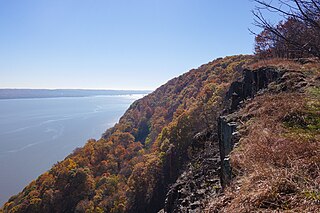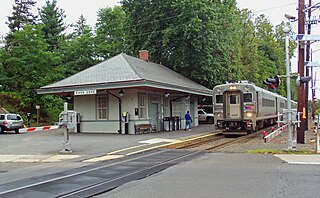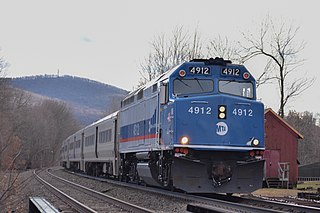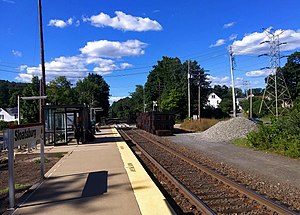
Rockland County is the second-southernmost county on the west side of the Hudson River in the U.S. state of New York, after Richmond County. It is part of the New York metropolitan area. As of the 2020 U.S. census, the county's population is 338,329, making it the state's third-most densely populated county outside New York City after Nassau and neighboring Westchester Counties. The county seat and largest hamlet is New City. Rockland County is accessible via the New York State Thruway, which crosses the Hudson to Westchester at the Tappan Zee Bridge ten exits up from the NYC border, as well as the Palisades Parkway five exits up from the George Washington Bridge. The county's name derives from "rocky land", as the area has been aptly described, largely due to the Hudson River Palisades. The county is part of the Hudson Valley region of the state.

Harriman is a village in Orange County, New York, United States. It is in the southeastern section of the town of Monroe, with a small portion in the town of Woodbury. The population was 2,714 at the 2020 census. It is part of the Kiryas Joel–Poughkeepsie–Newburgh, NY Metropolitan Statistical Area as well as the larger New York–Newark–Bridgeport, NY-NJ-CT-PA Combined Statistical Area.

Sloatsburg is a village in the town of Ramapo in Rockland County, New York, United States. Located east of Orange County, it is at the southern entrance to Harriman State Park. The population was 3,036 at the 2020 census. The village is named after Stephen Sloat, an early European landowner.

Suffern is a village that was incorporated in 1796 in the town of Ramapo in Rockland County, New York. Sitting adjacent to the town of Mahwah, New Jersey, Suffern is located 31 miles northwest of Manhattan. As of the 2020 census, Suffern's population was 11,402.

The Pascack Valley Line is a commuter rail line operated by the Hoboken Division of New Jersey Transit, in the U.S. states of New Jersey and New York. The line runs north from Hoboken Terminal, through Hudson and Bergen counties in New Jersey, and into Rockland County, New York, terminating at Spring Valley. Service within New York is operated under contract with Metro-North Railroad. The line is named for the Pascack Valley region that it passes through in northern Bergen County. The line parallels the Pascack Brook for some distance. The line is colored purple on system maps, and its symbol is a pine tree.

The Main Line is a commuter rail line owned and operated by New Jersey Transit running from Suffern, New York to Hoboken, New Jersey, in the United States. It runs daily commuter service and was once the north–south main line of the Erie Railroad. It is colored yellow on NJ Transit system maps, and its symbol is a water wheel.

NJ Transit Rail Operations is the rail division of NJ Transit. It operates commuter rail service in New Jersey, with most service centered on transportation to and from New York City, Hoboken, and Newark. NJ Transit also operates rail service in Orange and Rockland counties in New York under contract to Metro-North Railroad. The commuter rail lines saw 57,179,000 riders in 2023, making it the third-busiest commuter railroad in North America and the longest commuter rail system in North America by route length.

The Bergen County Line is a commuter rail line and service owned and operated by New Jersey Transit in the U.S. state of New Jersey. The line loops off the Main Line between the Meadowlands and Glen Rock, with trains continuing in either direction along the Main Line. It is colored on NJT system maps in grey, and its symbol is a cattail, which are commonly found in the Meadowlands where the line runs.

The Port Jervis Line is a predominantly single-track commuter rail line running between Suffern and Port Jervis, in the U.S. state of New York. At Suffern, the line continues south into New Jersey on NJ Transit's Main Line. The line is operated by NJ Transit Rail Operations under a contract with Metro-North Railroad (MNRR).

Salisbury Mills–Cornwall station is a commuter rail stop owned by Metro-North Railroad serving trains on the Port Jervis Line, located in the Beaver Dam Lake section of the town of Cornwall, New York. The station is located at the northern end of the Moodna Viaduct, accessible from NY 94.

Suffern station is a railroad station in the village of Suffern. The station, located on Ramapo Avenue in Suffern, services trains of New Jersey Transit's Main Line and Metro-North Railroad's Port Jervis Line. Suffern station serves as the terminal for Main Line trains, as trains continue north into Hillburn Yard. The next Main Line station, located in New Jersey, is Mahwah. The next Port Jervis Line station to the north is Sloatsburg. The station consists of two low-level side platforms for trains in both directions, neither of which are handicap accessible for the Americans with Disabilities Act of 1990.

Nanuet station is a train station in Nanuet, New York, serving commuter trains on the Pascack Valley Line. Its official address is 1 Prospect Street, but in reality, it is located on Orchard Street West, diagonally off the southwest corner of Prospect Street and Middletown Road.

Spring Valley station is an intermodal transit station in Spring Valley, New York. It serves commuter trains as well as buses as the Spring Valley Bus Terminal. The buses that serve the Spring Valley Bus Terminal are Rockland Coaches, Hudson Link, and Transport of Rockland. It is located on Main Street (Route 45), 0.125 miles (0.201 km) from Route 59.

Hawthorne is an active commuter railroad station operated by New Jersey Transit in the borough of Hawthorne, Passaic County, New Jersey, United States. It is the northernmost station in Passaic County along New Jersey Transit's Main Line. Trains coming through Hawthorne service Waldwick, Suffern and Port Jervis to the north and Hoboken Terminal to the south, where connections are available to New York City via Port Authority Trans-Hudson and ferries. The station, accessible only by Washington Place in Hawthorne, contains only two low-level platforms connected by a grade crossing. As a result, the station is not compliant with the Americans with Disabilities Act of 1990.

Allendale is a NJ Transit rail station served by its Main and Bergen County lines as well as Port Jervis Line trains. The station is located at the railroad next to Allendale, Park and Myrtle avenues in Downtown Allendale. The station consists of two low-level platforms serving trains heading between Hoboken Terminal and Suffern. Some westbound trains headed for Port Jervis also stop at Allendale. The station has two ticket vending machines along the inbound platform with three parking lots for commuters. The railroad depot, constructed in 1870, is a combined passenger and freight depot, with a waiting area for passengers at the south end of the building while the northern end is unused.

Mahwah station is a NJ Transit train station located in Mahwah, New Jersey served by the Main Line, Bergen County Line and a limited service served by Metro-North Railroad's Port Jervis Line.
Sterlington, was a tiny community located in the Town of Ramapo, Rockland County, New York, United States located between Suffern and Sloatsburg.

Sloat's Dam and Mill Pond is located between Waldron Terrace and Ballard Avenue in Sloatsburg, New York, United States. The 200-foot–long concrete dam creates the mill pond north of it by impounding the Ramapo River.
The recorded history of Rockland County, New York begins on February 23, 1798, when the county was split off from Orange County, New York and formed as its own administrative division of the state of New York. It is located 6 miles (9.7 km) north-northwest of New York City, and is part of the New York Metropolitan Area. The county seat is the hamlet of New City. The name comes from rocky land, an early description of the area given by settlers. Rockland is New York's southernmost county west of the Hudson River. It is suburban in nature, with a considerable amount of scenic designated parkland. Rockland County does not border any of the New York City boroughs, but is only 9.5 miles (15.3 km) north of Manhattan at the counties' two respective closest points
The 1958 Sterlington railroad disaster was a head-on collision by two Erie Railroad trains on August 11, 1958 at 6:47 AM killing 5 people and injuring 22 to 36. The collision occurred when the operator in the signal tower at Suffern failed to hold the westbound train No. 53 at Suffern for the eastbound No. 50 commuter train from Monroe, New York, to Hoboken, New Jersey. When he realized his error, he attempted to contact the crews via radio but was unsuccessful due to a radio dead spot. The trains impacted head-on right in front of the now abandoned Erie Railroad depot in Sterlington, New York near Sloatsburg, killing the crew of the locomotive No. 859 from train No.50 as well as two passengers and injuring the crew of the locomotive No. 1402 from the westbound train.




















